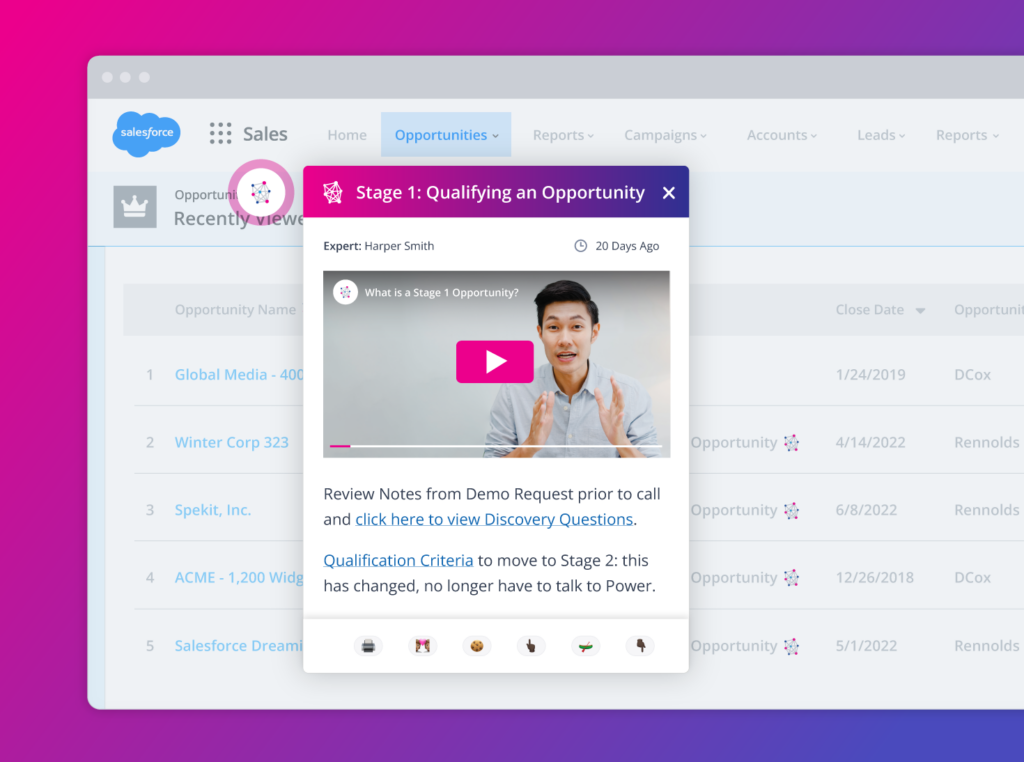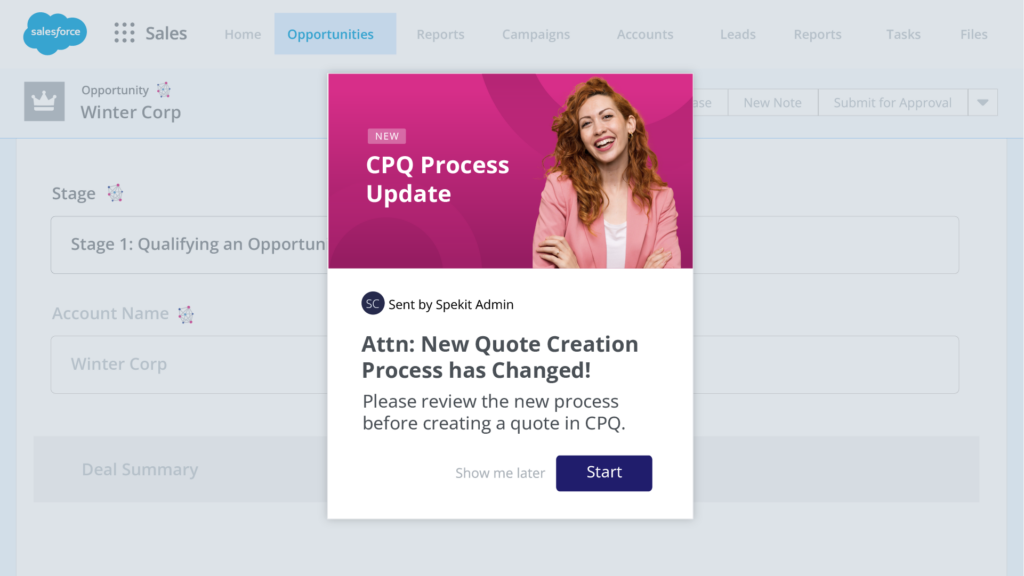Salesforce is an indispensable tool for organizations around the world. Its ability to store, organize, and process vast amounts of data can dramatically enhance business decision-making capabilities.
However, its effectiveness relies heavily on the quality of its data.
Inaccurate, outdated, or inconsistent data doesn’t just hinder your ability to make informed decisions about your business. It also negatively impacts Salesforce adoption within your organization. When employees struggle with unreliable data, it can lead to reduced usage and consequently, a poor return on your investment.
Fortunately, improving the quality of your Salesforce data doesn’t have to be a daunting task.
Let’s dive in to the basics and best practices of Salesforce data quality and explore how Spekit, the #1 trusted solution for Salesforce adoption, can help you overcome the challenges of creating and maintaining high-quality data within your organization.
Who is responsible for data quality in Salesforce?
Traditionally, the burden of data quality in Salesforce rests on the shoulders of Salesforce administrators and revenue operations leaders. These professionals are tasked with ensuring that the data entered into Salesforce is accurate, up-to-date, and relevant to the needs of the business.
Salesforce administrators are often overwhelmed by the volume of data-related tasks they must handle.
A significant amount of time is typically spent answering repetitive questions, doing manual data cleanup, and providing end-user support. Unfortunately, these time-consuming tasks prevent them from focusing on impactful, strategic work that can drive the business forward.
The problem is exacerbated by managers and other stakeholders who grow frustrated and resist Salesforce adoption, often due to inaccurate, unreliable data.
The challenges of maintaining and improving data quality in Salesforce
Unfortunately, maintaining and improving data quality in Salesforce presents considerable challenges. One of the main challenges is the time-consuming nature of Salesforce data entry.
Studies have shown that 40% of employees find Salesforce data entry tedious , which leads to frequent mistakes and messy data.
Another challenge lies in lengthy, monotonous onboarding and training processes. Suppose employees must sift through 70 slides of a Powerpoint presentation or a 100-page Google document to find out how to enter information or interpret data correctly. In that case, they may guess instead of wasting valuable time searching for answers.
Additionally, if resources are scattered within your organization, it can be difficult for employees to stay up to date on process changes and retain the necessary knowledge to accurately complete future tasks. Furthermore, getting employees on board with accurate data entry processes can be challenging if they don't understand how or why those processes matter and they aren't held accountable by leadership.
This causes growing frustration for employees and the managers of the tools and processes they've been asked to use, resulting in end users who don't recognize the value of Salesforce and admins banging their heads against a wall trying to communicate it.
Best practices to ensure Salesforce data quality
The good news is that improving data quality in Salesforce is a manageable task. By following a few Salesforce data quality best practices, businesses can significantly improve the accuracy and reliability of their information.
Establishing data quality rules is the first step in maintaining high-quality data.
A data quality rule is a simple, clear statement that defines the characteristics of the data you’re using. You will see the most benefit from these rules if they are specific to your organization and the appropriate representation of data in your systems.
Understanding the data quality process is also important.
Start by analyzing the current state of your data and evaluating its quality based upon your data quality rules. Then ensure that your data is free of duplicates, errors, and irrelevant or missing data.
Once you have a clean data set, work on standardizing your data standards and naming conventions that are reinforced through validation rules and picklists. It is also crucial to train all of your users on the data quality rules and standards so that they can accurately input and interpret information.
Maintaining high-quality data in Salesforce is an ongoing process but by establishing processes and controls to consistently measure the quality of your data, you can set your team up for success. As you establish these rules and standards, it is important to utilize tools that will ensure that your team is on the same page when it comes to your data fields and other data-related processes.
One of the most effective solutions is to set up a Salesforce data dictionary , an intuitive and business-focused tool for creating and documenting a shared vocabulary for your organization’s use of Salesforce.
With Spekit, you can easily set up a Salesforce data dictionary that will give your team access to the most current information, synchronize all of your data, assign internal subject matter experts, and track data integrations through custom metadata.
Preventing future data quality issues
Preventing data quality issues in the future requires a multifaceted approach. Improved change management, better data hygiene practices, and user adoption of tools like Salesforce are crucial.
However, it's not just about adopting the right tools and methods; organizations must also implement practices and processes that provide employees seamless access to reliable data within their flow of work, limiting disruptions and time wasted searching for resources.
One of the key aspects of preventing data quality issues is ensuring that employees have instant access to the information they need to use Salesforce correctly.
Providing clear instructions on how to use each field, explaining the importance of data accuracy, and making it easy for employees to find help when they encounter difficulties can significantly reduce the number of errors in data entry and increase the overall quality of your Salesforce data.
Spekit makes it easy to improve Salesforce data quality in the flow of work
Spekit empowers employees to rapidly adopt best practices that ensure better data hygiene and greater Salesforce adoption, resulting in fewer mistakes, consistent adherence to processes, and less resistance to change.
With a prestigious five-star rating on the AppExchange, Spekit is the robust just-in-time learning tool that will amplify the reliability of your data and streamline your team's Salesforce experience.
Take a closer look at some of Spekit's dynamic features designed to elevate your organization’s data quality and provide instant access to knowledge, when and where your employees need it:
One Click Salesforce Integration
Get started with a single click and customizable prebuilt content, giving your team quick access to relevant knowledge right in their flow of work.

Embedded Speks
Bite-sized, contextual, on-demand knowledge embedded in Salesforce shows users exactly what each field means and how to use it.

Spotlights
Spekit's in-app notifications/alerts allow you to quickly communicate process and field changes within your employees' workflow.

Knowledge Checks
Measure your team's understanding and reinforce technology and process changes with bite-sized assessments.

Flows
Spekit's no-code, step-by-step walkthroughs efficiently guide employees through products and processes, click by click.

Analytics
Spekit's analytics allow you to easily spot adoption gaps, ensuring you have the insights you need to make data-driven decisions.

Case Study
Teams large and small are using Spekit to improve the quality of their Salesforce data, enhance training, and drive Salesforce adoption within their organizations.
Southwest Airlines utilizes Spekit’s unique features to train and communicate with their employees without disrupting their workflow.
Spekit has enabled them to achieve 100% virtual training while increasing Salesforce adoption and decreasing poor data quality.
You can read the full case study here .

Poor data quality can have extensive consequences. When data is flawed or inconsistent, it can lead to misguided business forecasts and decision-making errors.
Research suggests that erroneous data can lead to a 10% loss in revenue due to inaccurate forecasting, the inability to diagnose problems, and costly mistakes.
Inaccurate data can also make it difficult for you to assess the health of your business. That’s why trustworthy data is crucial, particularly in today’s fast-paced business environment.
Spekit’s just-in-time learning platform is a comprehensive solution designed to drive Salesforce adoption, facilitate change management, and improve data quality so you can reach your business goals more quickly, improve ROI, increase revenue, and make better decisions about what’s working – and what’s not – within your organization.
Ready to learn more about how Spekit can refine your Salesforce data quality and help streamline workflows and boost productivity in your business?
Get more details on our product page or schedule a demo to see Spekit in action!
More like this
Make Every Employee Your Best Employee with Everboarding


.webp)




